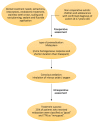Conscious Sedation in Dentistry for the Management of Pediatric Patients with Autism: A Narrative Review of the Literature
- PMID: 35455504
- PMCID: PMC9026963
- DOI: 10.3390/children9040460
Conscious Sedation in Dentistry for the Management of Pediatric Patients with Autism: A Narrative Review of the Literature
Abstract
(1) Background: the variety of autism spectrum disorder makes the definition of guidelines for dental care a challenging task. The aim of this review was to evaluate the literature concerning the use of conscious sedation for dental treatments in pediatric autistic patients. (2) Methods: we searched MEDLINE/PubMed, EMBASE, Cochrane databases in order to identify pertinent studies. The search strategy was based on these areas of interest: autistic spectrum disorder, pediatric patients, dentistry, tranquilizing agents, and conscious sedation. (3) Results: the search yielded 177 non-duplicated articles, of which 24 articles were retrieved for full text review, and 2 were found to address our review aim. The first paper was a retrospective study that included 83 autistic patients sedated either with an oral premedication combined with nitrous oxide/oxygen inhalation or with nitrous oxide/oxygen inhalation alone; the second article was a prospective trial on the effectiveness of 0.3 mg/kg of oral diazepam with 0.5 mg/kg of oral midazolam in 13 sedated uncooperative autistic patients. (4) Conclusions: this review highlights the insufficiency of studies that can provide concrete indications for the dental treatment in conscious sedation of pediatric patients with autism. New studies are needed to better define the appropriate drugs, dosages, sedation level and evaluate patient cooperation.
Keywords: autism spectrum disorder; conscious sedation; dentistry; pediatric patient; tranquilizing agents.
Conflict of interest statement
The authors declare no conflict of interest.
Figures
References
-
- Loo C.Y., Graham R.M., Hughes C.V. Behaviour guidance in dental treatment of patients with autism spectrum disorder. Int. J. Paediatr. Dent. 2009;19:390–398. - PubMed
-
- Mangione F., Bdeoui F., Costa M.D., Dursun E. Autistic patients: A retrospective study on their dental need and the behavioural approach. Clin. Oral Investig. 2020;24:1677–1685. - PubMed
-
- Herrera-Moncada M., Campos-Lara P., Hernández-Cabanillas J.C., Bermeo-Escalona J.R., Pozos-Guillén A., Pozos-Guillén F., Garrocho-Rangel J.A. Autism and Paediatric Dentistry: A Scoping Review. Oral Health Prev. Dent. 2019;17:203–210. - PubMed
-
- Da Silva S.N., Gimenez T., Souza R.C., Mello-Moura A.C.V., Raggio D.P., Morimoto S., Lara J.S., Soares G.C., Tedesco T.K. Oral health status of children and young adults with autism spectrum disorders: Systematic review and meta-analysis. Int. J. Paediatr. Dent. 2017;27:388–398. - PubMed
Publication types
LinkOut - more resources
Full Text Sources



